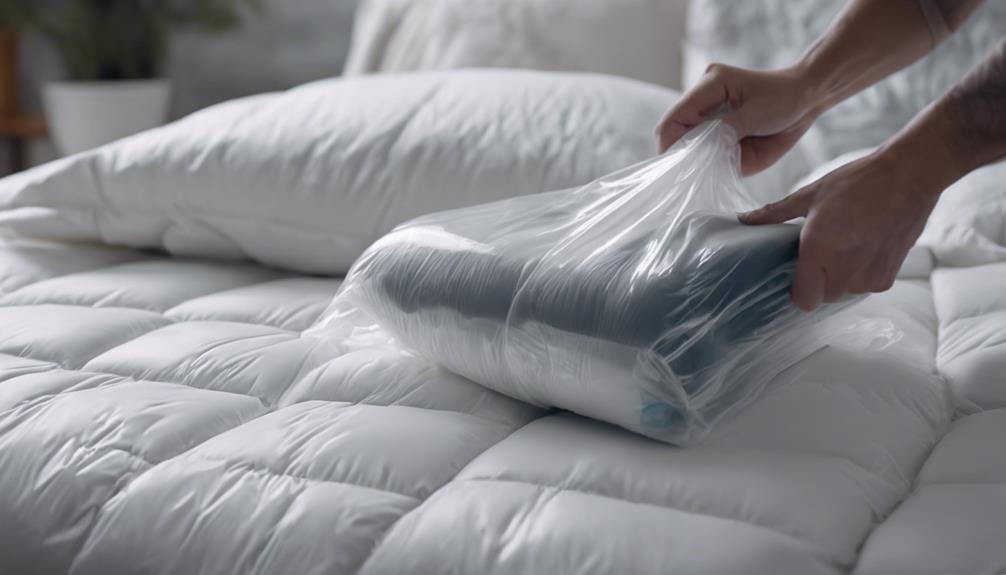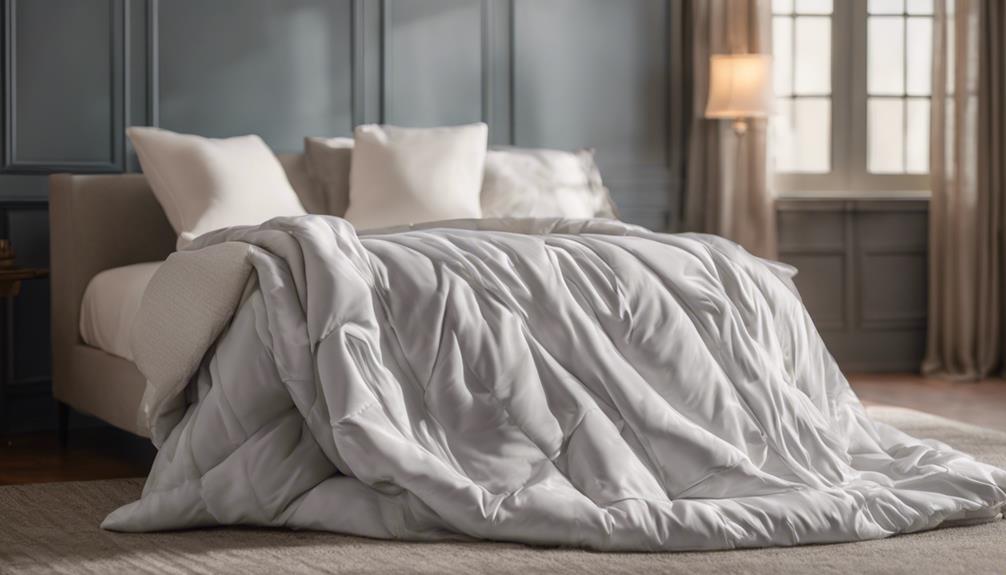Down comforters are beneficial for individuals with asthma because they are hypoallergenic and allergen-safe. Regular washing helps eliminate dust mites, and covers provide an additional barrier. These comforters are often asthma-friendly, providing excellent insulation and breathability for maximum comfort. It is recommended to choose hypoallergenic options with dust mite resistance. Some down comforters even have certifications like Asthma and Allergy Friendly. Instances of down allergies are rare, as proper washing effectively removes allergens. With proper maintenance, down comforters can be suitable for those with asthma. For more information on selecting the right down comforter for individuals with asthma, it is advised to consider additional details to make an informed decision.
Key Takeaways
- Down comforters are typically safe for asthma sufferers due to hypoallergenic properties.
- Regular washing eliminates dust mites and allergens, reducing asthma triggers.
- High-quality down comforters offer exceptional insulation without overheating.
- Proper care, like using allergen-proof covers, can enhance comfort for asthma patients.
- Synthetic pillows may contain more allergens than down-filled options.
Asthma-Friendly Qualities of Down Comforters
When considering the asthma-friendly qualities of down comforters, it's essential to acknowledge their natural hypoallergenic properties and resistance to dust mites. Down comforters are beneficial for asthma sufferers due to their innate ability to ward off allergens and dust mites, which are common triggers for asthma attacks.
Investing in an allergen-blocking protector for your down comforter can further enhance its asthma-friendly characteristics by creating an additional barrier against allergen exposure, promoting a restful night's sleep for individuals with asthma.
The hypoallergenic nature of down comforters guarantees that they're unlikely to cause allergic reactions, making them a suitable choice for asthma sufferers. Additionally, their resistance to dust mites adds to their appeal as a bedding option for those with respiratory conditions.
Benefits of High-Quality Down Comforters

High-quality down comforters offer exceptional hypoallergenic properties, making them a safe and comfortable choice for individuals with asthma. The tightly woven fabric of these comforters prevents allergens, including dust mites, from escaping, reducing the risk of asthma triggers. Additionally, the natural resistance of down comforters to dust mites provides further assurance for those with asthma and allergies.
The fill power of down comforters not only creates a lightweight and breathable bedding option but also helps in maintaining a comfortable sleep environment for asthma patients. These comforters provide excellent insulation without overheating, ensuring a restful night's sleep.
Furthermore, premium down comforters are durable, long-lasting, and easy to maintain, offering a sustainable and allergy-friendly bedding solution for asthma sufferers. Their quality construction and materials make them a practical choice for individuals looking for both comfort and health benefits.
Allergen-Proof Design of Down Comforters
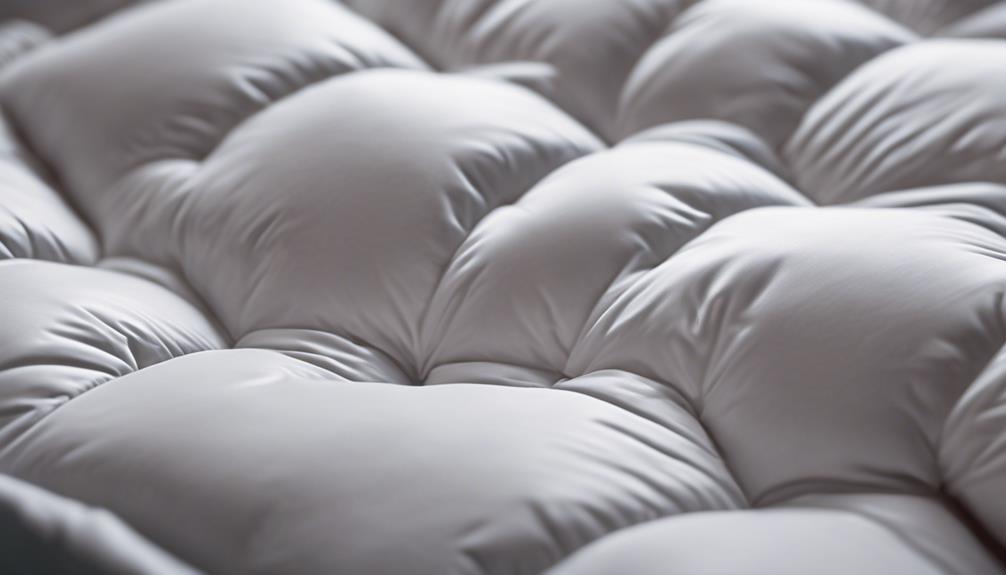
To guarantee a safe and allergy-free sleep environment for individuals with asthma, down comforters can feature an allergen-proof design through specialized washing processes and innovative materials. Specially washed goose down is a key component in creating allergen-proof comforters, ensuring they're safe for asthma sufferers.
Additionally, comforters like the Pinzon Primaloft Down Alternative option offer 100% allergen-free down alternative filling, providing a suitable choice for those with asthma. AllerRest comforters come equipped with a built-in allergy protector that prevents allergens from entering or escaping, further enhancing their allergen-proof design.
For individuals who prefer traditional down comforters, allergen-blocking protectors like Allersoft protectors offer a solution. The use of Barrierweave cotton in comforter protectors provides a lab-tested allergen-proof feature, making them a secure option for individuals with asthma.
Preventing Dust Mites in Down Comforters
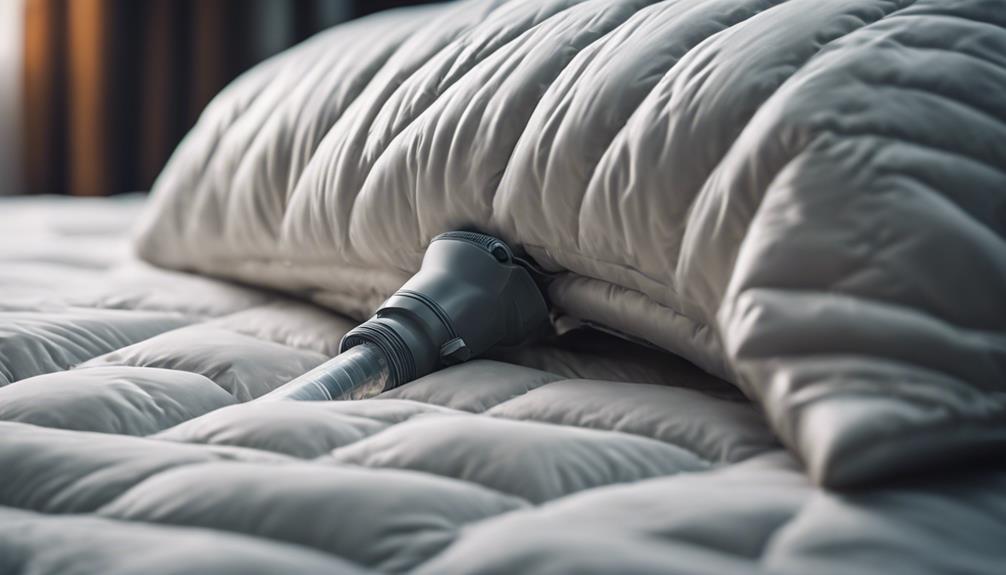
Implement regular maintenance practices to prevent dust mites in down comforters, establishing an asthma-friendly sleeping environment. Dust mites can trigger asthma symptoms, so it's important to take preventive measures. Here are some strategies to keep your down comforter free from these pesky allergens:
| Strategy | Description |
|---|---|
| Wash and Dry Regularly | Regular washing and drying can help reduce dust mites and allergen buildup in the comforter. |
| Freeze the Comforter | Freezing the comforter can effectively eliminate dust mites, providing a natural cleaning method. |
| Use Allergen-Proof Encasements | Encasements act as an extra barrier against dust mites and allergens, enhancing protection. |
| Choose High-Quality Down Comforters | Opt for down comforters with tight weaves to minimize dust mite risks and ensure a healthier sleep. |
| Consider Synthetic or Feather Pillows | Synthetic or feather pillows can be a better choice over down if dust mites are a significant concern. |
Proper Care and Maintenance of Down Comforters
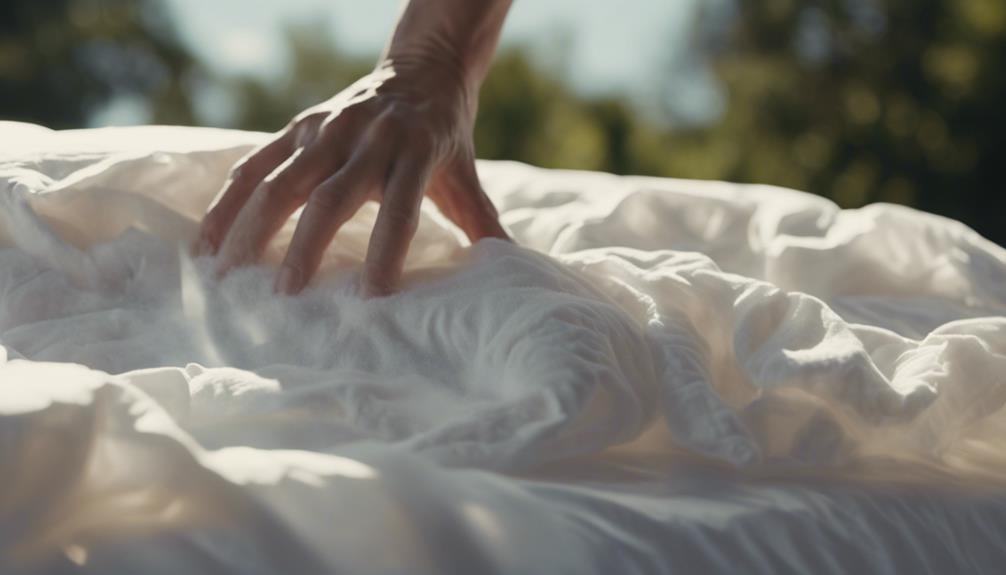
Regularly cleaning your down comforter and following proper storage tips are essential for maintaining its quality and longevity.
Washing and drying your comforter at high temperatures can help eliminate allergens and dust mites that could trigger asthma symptoms.
Cleaning Down Comforters
Maintaining the cleanliness and longevity of down comforters involves regular fluffing and airing to uphold loft and freshness. When it comes to cleaning down comforters, following the proper care guidelines is crucial. Here are some key points to remember:
- Clean down comforters every 2-3 years to prevent dust mite accumulation.
- Opt for dry cleaning to avoid damaging the delicate down clusters.
- Consider using a duvet cover to protect the comforter from dirt and allergens.
- Store down comforters in a breathable cotton bag in a cool, dry place to avoid moisture buildup.
Storage Tips
To ensure maximum longevity and freshness of down comforters, storing them in a breathable cotton bag is essential to prevent moisture buildup and maintain quality. It's important to avoid plastic bags or airtight containers as they can lead to odor retention and loss of fluffiness.
Keep down comforters in a cool, dry place away from direct sunlight to preserve the down fill's quality. Periodically fluff and air out the comforters when stored to prevent compression and maintain loftiness. Consider using vacuum storage bags to save space while still allowing the fill to breathe.
These storage tips not only help in dust mite avoidance but also maintain the overall quality of the comforter, whether it contains feather pillows or synthetic filling.
Importance of Allergen-Blocking Protectors
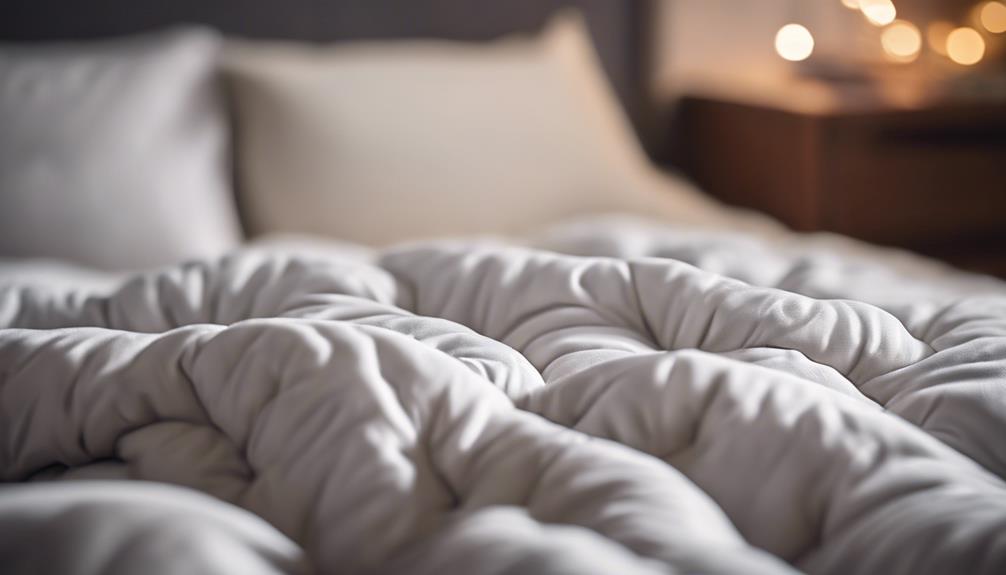
Allergen-blocking protectors are essential for preventing allergens from getting into or out of down bedding. These protectors, usually made of barrierweave cotton, have been proven in lab tests to be allergen-proof.
They offer a practical solution for those who love the comfort of down bedding but require protection from allergies.
Allergen Protection Benefits
How can down comforters be made asthma-friendly for sufferers?
Allergen-blocking protectors made of barrierweave cotton, like the AllerRest protector, can help prevent exposure to dust mite allergens, creating a safe sleep environment. These protectors have been lab-tested to be allergen-proof, allowing individuals to enjoy the comfort of a down comforter without triggering asthma symptoms.
Additionally, pillow protectors and feather bed protectors are available to provide thorough allergen protection for asthma sufferers. Investing in these allergen-blocking protectors for goose down bedding is a practical solution for maintaining a comfortable and asthma-friendly bedroom environment.
Cleaning and Maintenance Tips
Proper maintenance and regular cleaning play an essential role in preserving the hypoallergenic properties of down comforters, especially when complemented with allergen-blocking protectors. Using protectors like the AllerRest or Allersoft models can help prevent allergens from building up in down comforters, making them safer for asthma sufferers. Here is a simple guide for washing and drying your down comforter:
| Task | Frequency |
|---|---|
| Washing | Every 6 months |
| Drying | Every 1-2 months |
| Protector Change | Every 1-2 years |
Enhancing Asthma-Friendly Qualities of Down Comforters

Enhancing the asthma-friendly qualities of down comforters involves proper maintenance and cleaning to prevent dust mite buildup, ensuring a comfortable and safe sleep environment for asthma sufferers. When looking to make your down comforter more asthma-friendly, consider the following:
- Regular Washing: Washing your down comforter frequently can help eliminate dust mites and allergens that may trigger asthma symptoms.
- Choosing Allergen-Proof Covers: Investing in allergen-proof covers for your down comforter can provide an extra barrier against dust mites and other allergens.
- Opting for Hypoallergenic Properties: Selecting a high-quality down comforter with hypoallergenic properties can further reduce the risk of asthma triggers.
- Ensuring Breathability: The breathability and natural insulation of down can offer comfort without worsening asthma symptoms, making it a suitable choice for asthma sufferers.
Safety Measures for Allergy Sufferers
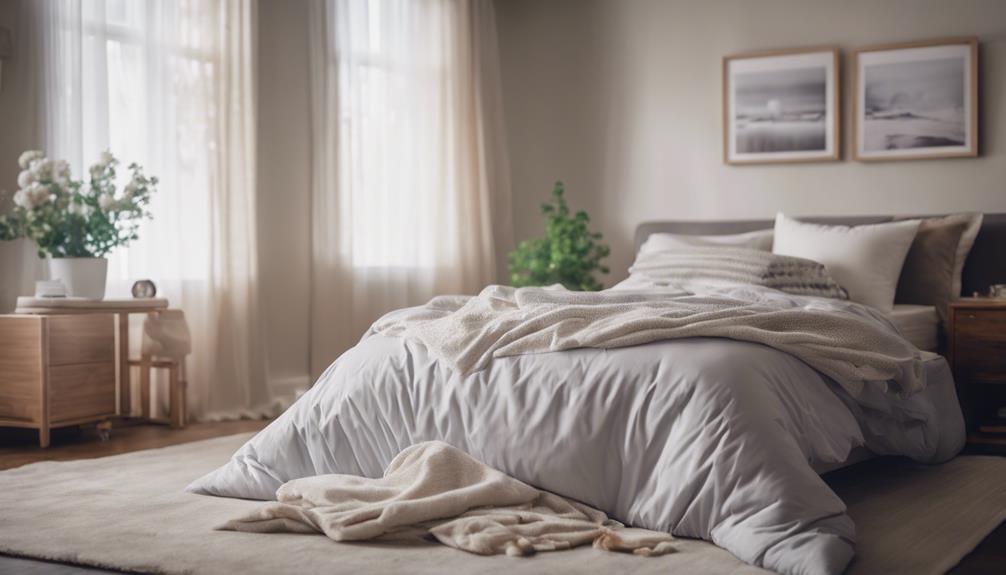
To guarantee a safe and allergen-free sleep environment, implementing particular safety measures can greatly benefit allergy sufferers. Down comforters are often allergen-safe and can be suitable for asthma patients. Allergic reactions related to down are rare, with dust mites being the usual culprits. Dust mites can trigger asthma symptoms, but proper washing techniques can effectively remove them from down comforters.
Unlike synthetic alternatives, down-filled comforters may harbor fewer allergens, making them a better choice for allergy sufferers. Freezing down products can also help eliminate dust mites, further reducing the risk of allergic reactions for asthma patients. By following these safety measures, individuals with allergies can enjoy the comfort and warmth of down comforters without compromising their health.
It's essential to maintain a clean and allergen-free sleeping environment to secure a restful night's sleep for allergy sufferers.
Choosing the Right Down Comforter for Asthma

When selecting a down comforter for asthma, consider the hypoallergenic qualities and dust mite resistance of high-quality options. It's essential to prioritize your health needs when choosing bedding.
Here are some key points to keep in mind:
- Hypoallergenic Properties: Opt for down comforters labeled as hypoallergenic to reduce the risk of triggering asthma symptoms.
- Dust Mite Resistance: Look for comforters that are specifically designed to resist dust mites, a common allergen that can worsen asthma.
- Certifications: Check for certifications like the Asthma and Allergy Friendly certification to make sure the down comforter meets hypoallergenic standards.
- Breathability: Choose a down comforter that allows for proper airflow to prevent overheating and maintain a comfortable sleep environment.
Myths About Down Comforters and Asthma

Many misconceptions surround down comforters and asthma, leading to confusion about potential triggers.
It's important to clarify that allergies to down are rare, with dust mites often being the real culprits.
Opting for hypoallergenic bedding and proper cleaning methods can help asthma sufferers enjoy the comfort of down-filled products without triggering respiratory issues.
Down Comforter Misconceptions
Contrary to common belief, down comforters aren't inherently harmful for those with asthma. Here are some common misconceptions about down comforters and asthma:
- Allergies to down itself are rare, with reactions typically related to dust mites within the bedding.
- Synthetic pillows may contain markedly more allergens than down-filled pillows.
- Proper washing techniques can effectively eliminate dust mites in down products, making them suitable for asthma sufferers.
- Research indicates that down-filled pillows have a protective effect and are safer for individuals with asthma.
These points highlight how down comforters, when properly maintained, can actually be a suitable bedding choice for individuals with asthma and allergies.
Asthma Triggers Clarified
Let's clear up some common misconceptions about down comforters and asthma to better understand their impact on respiratory health. Allergy to down is rare; reactions are usually to house dust mites in bedding. Down comforters can benefit asthma sufferers as they can be washed to remove dust mites.
Studies reveal that synthetic pillows may contain up to 8 times more allergens than down-filled pillows. Freezing down products can effectively eliminate dust mites, making them suitable for asthma. It's the material of the pillow shell, not the down filling, that affects allergen levels, making down comforters a safer choice for asthma and allergies.
Feather bedding can be a good option for those with respiratory issues.
Choosing Hypoallergenic Bedding
When selecting hypoallergenic bedding, it's important to dispel common myths surrounding the relationship between down comforters and asthma. Here are some key facts to keep in mind:
- Allergies to down comforters are rare, with reactions often attributed to dust mites rather than the down itself.
- Down comforters can actually be beneficial for asthma sufferers as they tend to have fewer allergens compared to synthetic alternatives.
- Properly washing down comforters can help eliminate dust mites and reduce allergy triggers.
- Freezing down bedding items is an effective method to eliminate dust mites, making them suitable for individuals with asthma.
Research supports the idea that hypoallergenic bedding, including down-filled pillows and comforters, can be safer options for those with asthma and allergies.
Frequently Asked Questions
What Is the Best Duvet for Asthma Sufferers?
When choosing a duvet for asthma, consider hypoallergenic options like down comforters. They're typically safe for asthma sufferers as down allergies are rare. Avoiding synthetic bedding that can trap more allergens is wise. Look for down-proof cotton shells to prevent dust mites.
Proper cleaning techniques can remove allergens, making down products suitable. Ultimately, down comforters can be a good choice for asthma sufferers seeking a comfortable and hypoallergenic bedding option.
Are Goose Down Comforters Bad for Allergies?
Goose down comforters aren't necessarily bad for allergies if properly maintained. High-quality options like the Pacific Coast AllerRest line undergo special washing to be allergy-safe. They provide warmth without trapping moisture for year-round use.
Allergen-blocking protectors, such as the AllerRest comforter protector, can enhance allergy safety. For those with sensitivities, hypoallergenic down alternative options like the Pinzon Primaloft Comforter are available.
Does Down Affect Asthma?
We find that down bedding can be beneficial for asthma sufferers. Dust mites, not down itself, tend to trigger allergies.
Washing down products removes allergens, and freezing can kill dust mites. Research even suggests down pillows may offer protection against asthma triggers compared to synthetic options.
As a result, down comforters can be a suitable choice for individuals with asthma, providing comfort without exacerbating symptoms.
What Kind of Pillow Is Best for Asthmatics?
For asthmatics, the best pillow choice is often down-filled. Down pillows, with their rare allergy reactions, can be safer than synthetic options that harbor more allergens.
Cleaning down pillows effectively eliminates dust mites and decreases asthma triggers. Research supports down's protective qualities for asthma sufferers, especially when paired with a down-proof cotton shell that reduces allergen exposure.
Opting for down pillows can be beneficial for those with asthma or allergies.
Are Down Comforters Safe for People with Asthma?
Yes, down comforters are generally safe for people with asthma. This is because down comforters are made with natural materials that are hypoallergenic and resistant to dust mites, making them a great choice for those with allergies. However, it’s always best to consult with a healthcare professional if you have concerns about using a down comforter and allergies.
Conclusion
To sum up, down comforters can actually be asthma-friendly due to their allergen-proof design and ability to prevent dust mites.
By selecting a high-quality down comforter and properly maintaining it, asthma sufferers can enjoy a cozy and comfortable night's sleep without exacerbating their symptoms.
Remember, not all down comforters are created equal, so it's important to do your research and find the right one for your needs.
As they say, a good down comforter can be a refreshing change for asthma sufferers.




